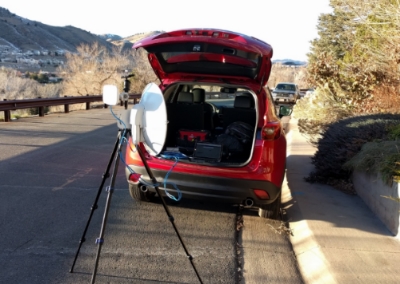Testing, testing and more testing
/When we started this project in August, 2015, I wanted to make sure we were going to use the fastest wireless system we could find for the money. That last bit is key - for the money. We did not want radios on members homes to go much past $100. For the access points on the towers, we wanted to stay under $500. So, that narrowed the field to a handful of vendors. I had years of experience with Ubiquiti hardware. I have deployed systems of a dozen radios up to 100+ radios using their hardware. In my mind, it was going to be the direction we were going to go.
We started by deploying a couple Rocket 5AC PtMP radios with UBNT 60 degree AC sector antennas. We bought some Nanobeam 5AC radios (NBE-5AC-19) as well as a couple PowerbeamAC radios (PBE-5AC-300-ISO) and began testing signals from various points all over our intended coverage area.
Let me back up slightly and describe the setup... We are a town in a valley. Our main antenna site is about 1700' above the town and coverage starts 1 mile out from the tower and goes about 5 miles out from the tower. For those that understand most sector antennas, you see an immediate issue.
However, we had other problems. First was firmware issues. Ubiquiti has been plagued with firmware issues. They develop hardware and software very quickly. Sometimes too quickly I think. Next came plain old performance issues. I was expecting to get 100+ Mbps radio to radio throughput with this set up. We were not seeing that in most locations we tested. We were getting 50 - 80 Mbps download and a little worse upload. The primary testing area was between 1.5 and 3 miles from the antenna. We made sure the narrow vertical beam of the sector was hitting where it needed to be. RF was clean on our 20 Mhz test channel.
This made me begin to doubt my immediate feeling to go with Ubiquiti and I started reading and reading. We tried LigoWave and a couple smaller vendors. Nothing we were happy with. I kept hearing Cambium get mentioned over and over again. After a long conversation with them, we decided to deploy some ePMP test gear. Through a local vendor who also had some expert advice for us, we started testing an ePMP 1000 GPS access point into a Cambium 120 degree sector. We started with the ePMP 1000 integrated CPE and then upgraded to add some new Force 180 radios along with the Force 110 into the mix. This was a very close match to the same CPEs offered by Ubiquiti.
Not to get into the weeds with details, I was amazed by how rock solid the ePMP gear is. We were getting 100 Mbps down (30 - 60 Mbps up) from nearly all of our test sites and there were no firmware issues. Also, signal to noise with the Cambium sector was about 10 to 15 dB better than what we were seeing with Ubiquiti. Keep in mind, we did test using the same frequencies with antennas pointed in the same direction with CPEs in the same location. It was a well orchestrated apples to apples test. And extremely time consuming. These tests ran nearly non-stop from late August into early December.
Then it came time for some antenna tests. The narrow vertical beam width of most traditional sectors was causing an issue due to our high antenna. I contacted RF Elements and ended up on the beta test for the new TwistPort antennas. I'll let you do the reading on them but they (on paper) solved exactly what we needed to solve. So, I deployed two of these, one on an ePMP and one on a Rocket 5AC.
The TwistPort performed significantly better than the UBNT AC sector. No lobes, great SNR and good vertical performance. CPEs that would not lock up on the AC sector worked with the TwistPort (which was also a 60 degree version). With the ePMP gear, it also performed very well but it drops off around 5.4 Ghz. The 5.7 and 5.8 is very crowded in our area so we need to be in 5.1 and 5.2. The TwistPort adapter is not yet tuned to go that low. This was a major bummer because the size, price and performance are there for this antenna - just not yet at the low bands.
But, we decided to buy a couple RF Elements carrier class sectors that have fantastic 5.1 performance. Putting these on the ePMP radios (we had decided to move past Ubiquiti by now) brought our signals from around -65 to -55 and added 10 dB to the SNR. Speeds increased around 25 Mbps. This is just by putting these sectors on the AP. I am very pleased with them and would recommend anyone needing a sector antenna, look at RF Elements and if you are 5.7 / 5.8 Ghz, try a TwistPort. You won't be disappointed.
We created a detailed spreadsheet (thanks to the RF Elements beta program) were we tracked upload and download signal strength, SNR, radio to radio speed tests and speed tests to the Internet over a 100Mbps connection. We ran 2 full sets of tests with the Rocket 5AC PtMP radio - one into the UBNT AC sector and one into the RF Elements TwistPort. We had about 12 test sites in the coverage area and tested both the NBE and PBE radios at each location.
Then, we repeated this with the Cambium ePMP radio. Two full suits of tests with the Cambium 120 sector and then the RF Elements TwistPort. CPEs were Force 180 and Force 110 radios at each test site. These are almost exact matches to the NBE and PBE products from Ubiquiti - except Cambium does not have an AC product.
After all this, two things were very clear:
1) My wife was getting very tired of the UPS guy stopping by every day with boxes.
2) Cambium ePMP products out performed Ubiquiti AC equipment in our test environment 95% of the time (there was one radio location where UBNT gear was slightly better in speeds).
If you are interested in seeing the full spreadsheet, contact us and I will be happy to send it along. It has been shared with RF Elements (as part of the beta program) and Cambium.
While none of this was written as a paid endorsement, I am very pleased to be working with Cambium for our co-op WISP and thank RF Elements for a well performing antenna line.




